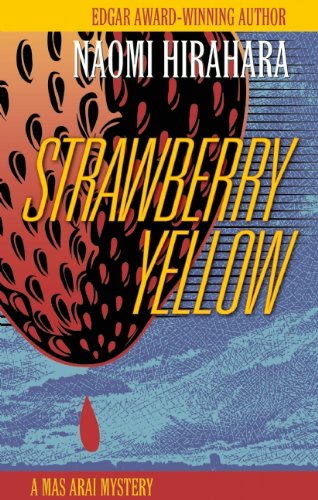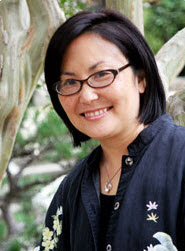18 Mar Naomi Hirahara, author of “Mas Arai” mystery novels, comes to Denver for a reading
 I’ve always been a fan of detective and crime mystery fiction, starting from my earliest days devouring the Hardy Boys and Three Investigators books when I was just a kid. I graduated to author Agatha Christie (including her female sleuth Miss Marple), Ellery Queen and of course, Sir Arthur Conan Doyle’s Sherlock Holmes. Then in college I fell in love with the hard-boiled noir novelists, such as Dashiell Hammett and Raymond Chandler.
I’ve always been a fan of detective and crime mystery fiction, starting from my earliest days devouring the Hardy Boys and Three Investigators books when I was just a kid. I graduated to author Agatha Christie (including her female sleuth Miss Marple), Ellery Queen and of course, Sir Arthur Conan Doyle’s Sherlock Holmes. Then in college I fell in love with the hard-boiled noir novelists, such as Dashiell Hammett and Raymond Chandler.
Among this pantheon of excellent writers and their incredible fictional sleuths, these days I look forward to each new book by Naomi Hirahara in her Mas Arai series.
Arai is a little like Miss Marple — an unlikely crime-solver in the guise of a senior citizen. But he’s unlike everyone else I’ve read, because he’s a 70-something Nisei, or second generation Japanese American who was born in California but spent his childhood in Japan. He survived the bombing of Hiroshima and returned Stateside, where the plot of “Strawberry Yellow” takes root. It starts with the funeral of Mas’ second cousin Shug in Watsonville, California, where Mas worked on a strawberry farm upon his return from Japan after WWII. Shug grew up to become a renowned strawberry expert, cultivating new strains.
Mas grew up a little rough around the edges, but became a gardener in Los Angeles, married and had a daughter who’s now grown and he lives alone since the death of his wife. He’s a crusty old man who avoids conflict and also people, and hates controversy but seems to always find himself in the middle of a murder, or theft, or some other crime. And in spite of his quirky and thorny personality, he solves the problems.
You won’t find a sleuth like Mas Arai in the annals of crime fiction.
 Along the way, Hirahara, who is herself the daughter of a gardener who was raised in Hiroshima, does a stellar job of accurately and lovingly reflecting her Japanese American (JA) community, including cultural traditions, venerated Japanese values, tangled family ties and the language. That includes not only lots of Japanese terms (she has a handy glossary online of some Japanese terms used in the Mas Arai books), but also capturing the heavily accented English of older JAs.
Along the way, Hirahara, who is herself the daughter of a gardener who was raised in Hiroshima, does a stellar job of accurately and lovingly reflecting her Japanese American (JA) community, including cultural traditions, venerated Japanese values, tangled family ties and the language. That includes not only lots of Japanese terms (she has a handy glossary online of some Japanese terms used in the Mas Arai books), but also capturing the heavily accented English of older JAs.
The language isn’t the one that’s stereotyped in racist jokes with the “L”s turned into “R”s. Mas is a man of few words, and speaks in a clipped, no-nonsense declarative voice, usually in short sentences: “Youzu bleedin'” and “We needsu to get outta here.”
His voice is so familiar to any JA who’s grown up around older Issei (first generation) or Nisei, that it’s like sitting down to a family dinner. Yet Hirahara balances the dialect and the Japanese words (even more so now than in the early books) so that non-Japanese can follow the narrative.
The plots themselves are unique, because they are cut from the experience of Japanese and Japanese Americans. The debut novel, “Summer of the Big Bachi,” takes Mas back to his childhood experiences in Hiroshima, and a man he knew back then. In the second title in the series, “Gasa-Gasa Girl,” Mas heads to Brooklyn to help his daughter Mari, and solve the murder of her half-Japanese boss. In “Snakeskin Shamisen” a friend of Mas is killed after winning half a million dollars from a slot machine, and Mas follows clues including an Okinawan shamisen, a traditional three-stringed lute. “Snakeskin Shamisen” won a coveted Edgar Allan Poe mystery book award for Paperback Original. In the most recent installment before “Strawberry Yellow,” “Blood Hina,” Mas follows clues from the theft of antique Japanese dolls which causes his best friend to cancel his wedding.
All of the books are a pleasure to read — they benefit from Hirahara’s early career as a journalist — and they inform audiences of the subtleties of Japanese culture as it has settled into American society. It’s different from Japanese culture, yet deeply connected to Japanese values. Mas Arai is a fine representative of that community and its traditions.
For Denver readers, Hirahara is coming to town for a reading and book signing at 7:30 pm this Wednesday, March 20 at the Tattered Cover Bookstore, 2526 E. Colfax Avenue. Come out and meet an award-winning mystery author, who has captured the essence of what it’s like to be Japanese American (and solve crimes).
I sent Hirahara some questions via email and she’s been nice enough to reply:
1. How did you come up with the Mas Arai character? Is he based on someone in your family?
The character of Mas Arai was inspired by my late father, whose nickname was Sam (spell it backwards and what you get?). They share some of the same life histories: gardener and Hiroshima survivor. Both were born here, raised in Japan and then returned to California.
2. How much research do you end up doing for each of your books. That is, did you know a lot about Okinawan culture before “Snakeskin Shamisen,” or about Brooklyn before “Gasa-Gasa Girl?”
I try to take on topics that I’ve written before in nonfiction or experienced firsthand. I do believe in the sacred purpose of nonfiction, especially in capturing stories of people of color. However, there are times where I have to do a lot of original research for the Mas Arai novels. For example, I didn’t know much about the Brooklyn Botanic Garden or the landscaper who designed its Japanese Hill-and-Pond Garden, Takeo Shiota. That required a special visit to New York City, as well retrieving Shiota’s essays from the New York Public Library. Sadly, the Brooklyn Botanic Garden had little information about Shiota; it’s believed that he died in some detention center on the East Coast. Since Shiota and his wife, who was white, didn’t have any children, a lot of history has not been preserved. Amazingly, due to the efforts of a Japanese journalist, I was able to meet Takeo’s nephew’s wife during her visit to LA. Also, some young researchers from New York have contacted me in their pursuit to piece together his history. So ironically, here, fiction has led to nonfction interest.
3. Does it get easier to write these books because you feel you know the character and his world better each time?
It is easier because I know Mas, his cronies and family members. Sometimes I have to be careful because I may be writing myself in a corner. For instance, a development in some character’s life may affect the next book.
4. I think Japanese Americans sink into your books because the characters and settings are so familiar…. Do you worry about whether references will or won’t be understood by non-JA readers?
What’s really fascinating is most of my readers are not Japanese American! I don’t think that I could be continued to be published by mainstream presses if the books were not embraced by a wide swath of people. The Mas Arai mysteries are very pungent — some are turned off by the smell; some love it. Now with mystery number five, I’m not as worried how it will play among non-JA readers. (Also, more and more young people are fascinated by Japanese culture because of anime and manga and are attracted to my books because of all the Japanese references.) I have adjusted the number of Japanese phrases I use. I also have edited out some of the dialect. STRAWBERRY YELLOW is my first title without a Japanese word. Fun thing is that some booksellers have gotten confused and called it YELLOW STRAWBERRY!
5. How do you get your inspirations for the plots in your books? Do you struggle for them, or do they pop into your head suddenly?
When I start a new book, I select a dedicated journal and begin writing notes. It could be a character, a plotline, or clue. Many times it does begin with a clue because how can Mas solve a crime when a police detective can’t? There are challenges working with an amateur sleuth. For example, how does he come across a dead body? Also, I can’t keep duplicating the circumstances (cause of death, type of victim, etc.), so I do consciously attempt to change it up. Many times I myself don’t know who committed the crime until the latter half of the book. That way it’s fun for me, too.
I’m doing subtle things that inspire me creatively. For instance, the first book had global weight; the second, more an Agatha Christie-type domestic puzzle; the second, political mystery; fourth, drug and spy; and fifth, bio-thriller. These elements won’t be apparent to any reader because this all happens in Mas’s contained world. But they are craft challenges that push me.
6. You mentioned you’re using less Japanese than in the past. One of the things I love about Mas Arai is that though he’s Nisei (kibei, technically), since he lived in Japan before and during the war his English is more heavily accented than many JAs, including Nisei. Did you father speak with that accent?
Most definitely. People who knew him said that they can imagine him saying the things Mas says.
7. It’s always refreshing to me to read it and hear it in my head, spoken by dozens of older, Japanese-born JAs I’ve known. Do you hear it in your head too, and the words and their spellings naturally come out, or do you sometimes struggle with how Mas might say a phrase?
I definitely hear it in my head. When you are writing dialect, you are essentially creating your own language. It’s a representation of what is heard. I would never write, “solly” for “sorry” (or “lice” for rice,” for that matter), because those kind of representations demean the speaker. That’s not my intention.
8. You have experience writing about landscaping, flowers and even strawberries in non-fiction books. [Hirahara has written non-fiction books including ones about JA gardeners, the flower industry, and a biography of a Nisei strawberry farmer.] Was “Strawberry Yellow” a natural one to write, with its plot, as they say, in your “wheelhouse?” Or, rather, “wheelbarrow….”
I felt very comfortable writing about strawberries. They have a long, global history, and because they are easily susceptible to disease, breeding is very important. Strawberries have a mother and father; they can be seen as a metaphor for human families, too.




